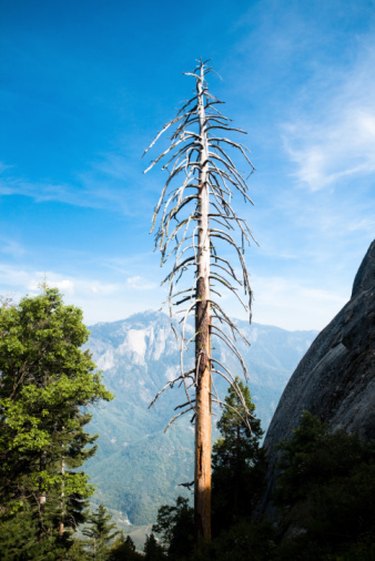
Evergreens often die slowly and parts of the tree might show signs of life even when there's no hope of recovery. Yellowing needles could be part of the tree's normal life cycle, since evergreens shed needles in stages. Evergreen foliage lasts from two to 10 years depending on the species. Some evergreens shed needles gradually, while others, such as white pine, drop old needles over a short period in autumn. New needles replace those that fall, but most new growth takes place at the outer border of the canopy. Interior branches gradually shade out and die back.
Step 1
Inspect the tree's canopy. Healthy evergreens show mostly green foliage even when shedding old needles. Branches with only brown needles, interspersed with healthier branches with green foliage, mark a tree that's under stress but not dead. Drought, disease and soggy ground all could cause this damage.
Video of the Day
Step 2
Test green needles and evergreen leaves by bending them between your fingers. Healthy foliage flexes without breaking. Dead needles need some drying time before turning brown, but dead foliage dries out quickly and snaps when flexed even if still slightly green.
Step 3
Test the bark on the tree's trunk at the base if you've found extensive damage to the tree's canopy. Cut a slit in the bark with the point of your knife and chip away or pry aside the dead dry outer bark. Look for a green cambium layer above moist sapwood. Dry brown bark all the way to the sapwood means at least a major injury to the tree. If dead bark girdles the tree, it can't be saved.
Tip
Evergreens that turn yellowish-green and drop needles might simply need water. Newly transplanted trees need time to establish root systems and require regular watering during dry weather, even in winter. Widespread canopy damage, including dead limbs and branches with a mixture of green and brown needles, could signal root rot due to soggy ground. Trees planted in poorly drained areas might grow normally in dry years but die during unusually wet weather. Pruning out dead branches improves the tree's appearance if dry weather allows recovery, but only improving the drainage solves the real problem. Evergreens with dead growth above ground might show patches of living wood when cut. Most evergreen trees don't produce new growth from living stumps. Removing severely damaged trees makes the best practical sense. Replant a type that's better suited to your local conditions.
Video of the Day
- Purdue Yard & Garden News; Evergreen Needles Don't Last Forever; B. Rosie Lerner; September 2010
- Utah State University Forestry Extension; What Is A Tree?; Michael Kuhns; April 1, 2008
- "Home Gardeners Headline Newsletter"; Pruning Ornamental Shrubs; May 29, 2006
- Purdue Yard & Garden News; Pruning Evergreens; B. Rosie Lerner; April 2002